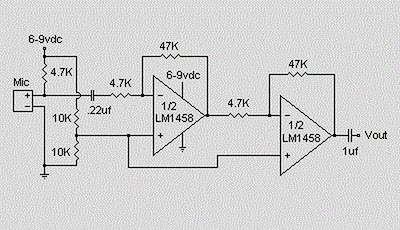This is a simple preamplifier circuit for electret condenser microphone.
using a LM1458 dual op amp IC. The circuit takes the audio signal rom the condenser microphone and amplifier it, so you can use the microphone as the input to some device which wouldn’t normally accept microphone level signals .

Schematic Circuit of Microphone Electret
Condenser Pre Amplifier
The circuit requires a 6-9 volt supply. Output of the microphone amplifier can be made variable by connecting a 10kΩ potentiometer . Circuit’s gain can be increased by men perbesar the value of 47K, depending on the input sensitivity of the main amplifier system. The microphone should be housed in a small round enclosure.
List componet of condenser pre-amp mic circuit
Q1,Q2 : LM1458 Op-Amp
R1,R2,R3 : 4.7k ohm resistor
R4, R5 : 10k ohm resistor
R6,R7 : 47k ohm resistor
C1, : 0.22uF ceramic capacitor
C2 : 1uF ceramic capacitor
Absolute maximum ratings of LM 1458 IC
Supply Voltage : ±18V
Power Dissipation : 400 mW
Differential Input Voltage : ±30V
Input Voltage : ±15V
Output Short-Circuit Duration: Continuous
Operating Temperature Range : 0°C to +70°C
Storage Temperature Range : −65°C to +150°C
Lead Temperature :(Soldering, 10 sec.) 260°C
Comments
Post a Comment